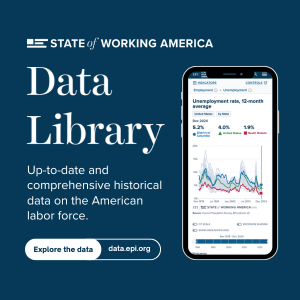The bad economy is not just a state of mind
Robert Samuelson argued this past Sunday that lack of confidence is a factor holding the economic recovery back – pointing to low rates of consumer spending and business investment as evidence. One hears (or a variant – that it’s “uncertainty” holding back the economy) a lot, so it’s important to note that there’s no evidence for it.
Larry Mishel has shown that the argument that business uncertainty about regulation and taxation is holding back the recovery has no evidence behind it. One thing he could’ve added to this is the fact that capacity utilization rates – think of them as the employment rate of the nation’s capital stock rather than its labor force – remain very low – 77.3 percent in August, compared to a non-recessionary average of 80.8 percent between 1979 and 2007.
The uncertainty argument is supposed to be about firms not wanting to make commitments to future costs – so they eschew investment and long-term hiring. But, as Larry’s paper shows, they’re not eschewing investment (equipment and software investment is currently actually outperforming the last three recoveries). Firms are also not using their current stock of productive inputs – the incumbent workforce and plant and equipment – at anywhere near full capacity. What does uncertainty have to do with not working your current workers as many hours per week as you did before the recession or running your factories as long?
What would keep businesses from working their labor force as hard as they did pre-recession or running factories at the same pace? Lack of demand – the other (and actually convincing) explanation for why the recovery remains so sluggish.
Samuelson (and others) also points to consumers’ lack of confidence as inhibiting recovery – and this could, in theory, be the cause of weak consumer spending. Of course, the $8 trillion reduction in wealth erased by the housing bubble’s burst could explain this as well (and does a much better job of it).
Further, it’s important to note that today’s levels of consumer spending and saving do not look obviously “too low” by any measure. The jump in personal savings from just about 1.5 percent of disposable income in 2005 to over 6 percent by the end of 2008 was a large driver of the recession – households, seeing themselves much less wealthy because of the housing bubble’s burst decided to stop spending so much and this was a key driver of the downturn. But, a 6 percent personal savings rate may just be the appropriate one for households that don’t see their assets inflated by stock or housing bubbles. From 1979 to 1996 (right before the stock market bubble really reached absurd levels) the personal savings rate averaged 7.6 percent.
So, is behavior by today’s consumers really about excessive “fear?” Not obvious to me. And is today’s corporate behavior evidence of excessive risk-aversion, or of just poor sales?
Again – the traditional Keynesian diagnosis of deficient demand is old and has gotten boring to many. But it has the virtue of actually being correct. Today’s sluggish economy simply needs more spending (and government is the only sector likely to provide it in the near-term), not pep talks.
Enjoyed this post?
Sign up for EPI's newsletter so you never miss our research and insights on ways to make the economy work better for everyone.
